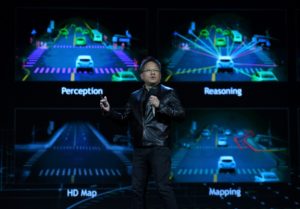
Holograms and Alexa are Coming to a Car Near You
Holograms and Alexa are Coming to a Car Near You
A series of emerging technologies is taking aim at transforming how drivers interact with their cars.
While the world waits for self-driving cars to come of age, this year’s Consumer Electronics Show in Las Vegas is showcasing several emerging technologies meant to benefit human drivers.
BMW, for instance, plans to use holographic technology to create a free-floating screen next to the steering wheel. The full-color display will show controls for, say, air conditioning or in-car entertainment, while a camera detects the position of the driver’s finger relative to the display, allowing them to adjust controls by poking at a screen made of light. It’s not clear when the technology will arrive in cars, but a gesture control system shown off by the automaker in 2015 is already available in production models.
Meanwhile, Ford has announced that it will drag Amazon’s smart assistant, Alexa, out of the home and into the automobile. Passengers will be able to ask Alexa to perform tasks that might usually require paying attention to the center console—making requests for snack stop locations, weather forecasts, or music, for instance.
In both cases, the automakers are clearly looking to keep drivers’ eyes on the road. That’s an admirable goal given that distracted driving deaths are on the rise and semi-autonomous vehicles could compound the problem. It remains to be seen, however, where the trade-off lies. Extra convenience and more features that make the cabin feel more like a lounge than a car could conceivably cause greater distraction, rather than attenuating its effects.
 Nvidia CEO Jen-Hsun Huang delivers a keynote address at CES 2017.
Nvidia CEO Jen-Hsun Huang delivers a keynote address at CES 2017.
That’s a problem that Nvidia’s latest plan could address, though. The company has announced that it wants to use semi-autonomous driving technology to make manual driving safer. The idea is to use sensors that are increasingly dotted around cars, such as cameras and radar, to augment human perception of road conditions. Its system will then intelligently provide cues by using cameras to detect what a driver hasn’t seen.
As well as diminishing the problem of distracted driving, such a setup might be one way to solve what those in the field of autonomous driving call “the hand-off”—the process by which a computer hands control of the vehicle back to a human. Such aids do, of course, need to be used with some caution: manual driving will always require concentration. But if drivers are able to stay alert, they could help make the roads a little safer.
(Read more: Reuters, Wired UK, The Verge, “Semi-Autonomous Cars Could Increase Distracted Driving Deaths,” “Rebooting the Automobile,” “A $799 Device That Brings Your Phone to Your Windshield”)

Leave a Reply